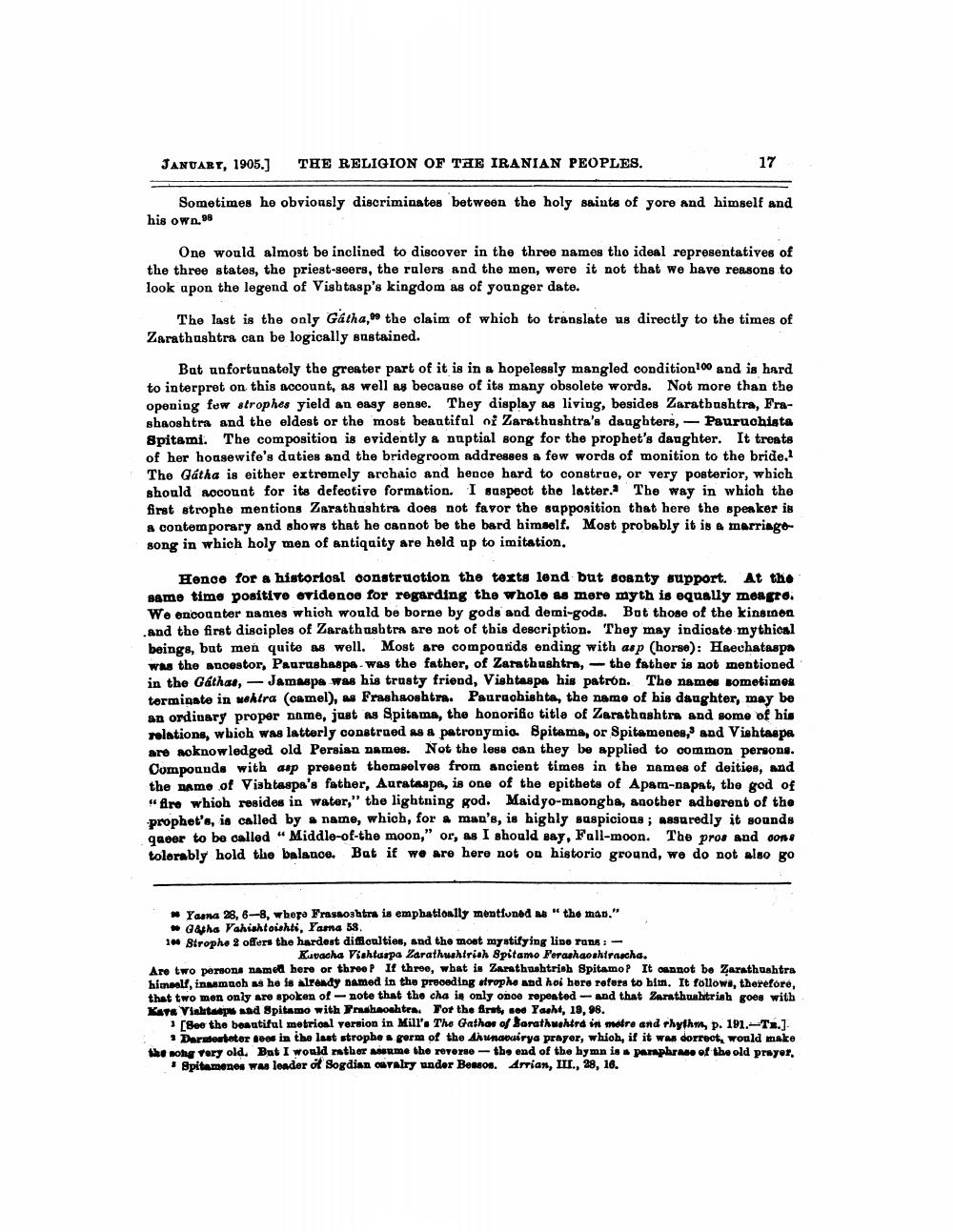________________
JANUARY, 1905.]
THE RELIGION OF THE IRANIAN PEOPLES.
17
Sometimes he obviously discriminates between the holy saints of yore and himself and his own."
One would almost be inclined to discover in the three names the ideal representatives of the three states, the priest-seers, the ralers and the men, were it not that we have reasons to look upon the legend of Vishtasp's kingdom as of younger date.
The last is the only Gatha, the claim of which to translate us directly to the times of Zarathushtra can be logically sustained.
But unfortunately the greater part of it is in a hopelessly mangled condition 100 and is hard to interpret on this account, as well as because of its many obsolete words. Not more than the opening few strophes yield an easy sense. They display as living, besides Zaratbashtra, Frashaoshtra and the eldest or the most beautiful ni Zarathushtra's daughters, Pauruohista Spitami. The composition is evidently a nuptial song for the prophet's daughter. It treats of her housewife's duties and the bridegroom addresses a few words of monition to the bride. The Gátha is either extremely archaic and hence hard to constrae, or very posterior, which should account for its defective formation. I suspect the latter. The way in which the first strophe mentions Zarathashtra does not favor the sapposition that here the speaker is a contemporary and shows that he cannot be the bard himself. Most probably it is a marriage song in which holy men of antiquity are held up to imitation.
Hence for a historioal construotion the texts lend but soanty support. At the same time positive evidence for regarding the whole se mere myth is equally meagro. We encounter names which would be borne by gods and demi-gods. But those of the kingmon and the first disciples of Zarathustra are not of this description. They may indicate mythical beings, but men quite as well. Most are compoarids ending with asp (horse): Haechataspa was the ancestor, Paurushaspe was the father, of Zarathushtra, - the father is not mentioned in the Gathas, - Jamnapa was his trusty friend, Vishtaspa his patron. The namos sometimes terminate in wehtra (camel), as Frash oshtra. Pauracbishta, the name of his daughter, may be en ordinary proper name, just as Spitama, the honorifio title of Zarathoshtra and some of his relations, which was latterly construed As & patronymio. Spitama, or Spitamenes, and Vishta pa are acknowledged old Persian names. Not the less can they be applied to common persons. Compounds with aap present thomsolves from ancient times in the names of deities, and the name of Vishtaspa's father, Aurataapa, is one of the epithets of Apam-napat, the god of
fire which resides in water," the lightning god. Maidyo-maongba, another adherent of the prophet'a, in called by name, which, for a man's, is highly suspicious ; Assuredly it sounds qacer to be called “Middle-of-the moon," or, as I should say, Fall-moon. The pros and cons tolerably hold the balance. But if we are here not on historio ground, we do not also go
Yoona 28, 6-8, whepa Frasaoshtra is emphatioally mentioned as "the man." # Gatha Vahishtoishti, Yama 58. 10. Strophe offers the hardest difficulties, and the most mystifying line rane: -
Kuvacha Vishtarpa Zarathushtrish Spitamo Perashashtraacha. Are two persons named here or three P If three, what is Zarathushtrish Spitamo? It cannot be Zarathushtra himself, inasmuch as he is already named in the preceding strophe and hoi here refers to him. It follows, therefore, that two men only are spoken of note that the cha is only ODOO repeated and that Zarathuahtrish goes with Kate Viata and Spitamo with Prashnoshtra. Tot the first soe Yacht, 18, 98.
1 [See the beautiful metrical version in Mill'. The Gathos of Sarathustra in motre and rhythm, p. 191.-T..]
Deretesteter toes in the last strophe germ of the Anunaouirya prayer, which, if it was correct, would make the song very old. But I would rather warme the reverse - the end of the hymn is . paraphrase of the old prayer,
Spitamenes was leader oł Sogdian cavalry under Bensos. Arrian, III., 28, 16.




